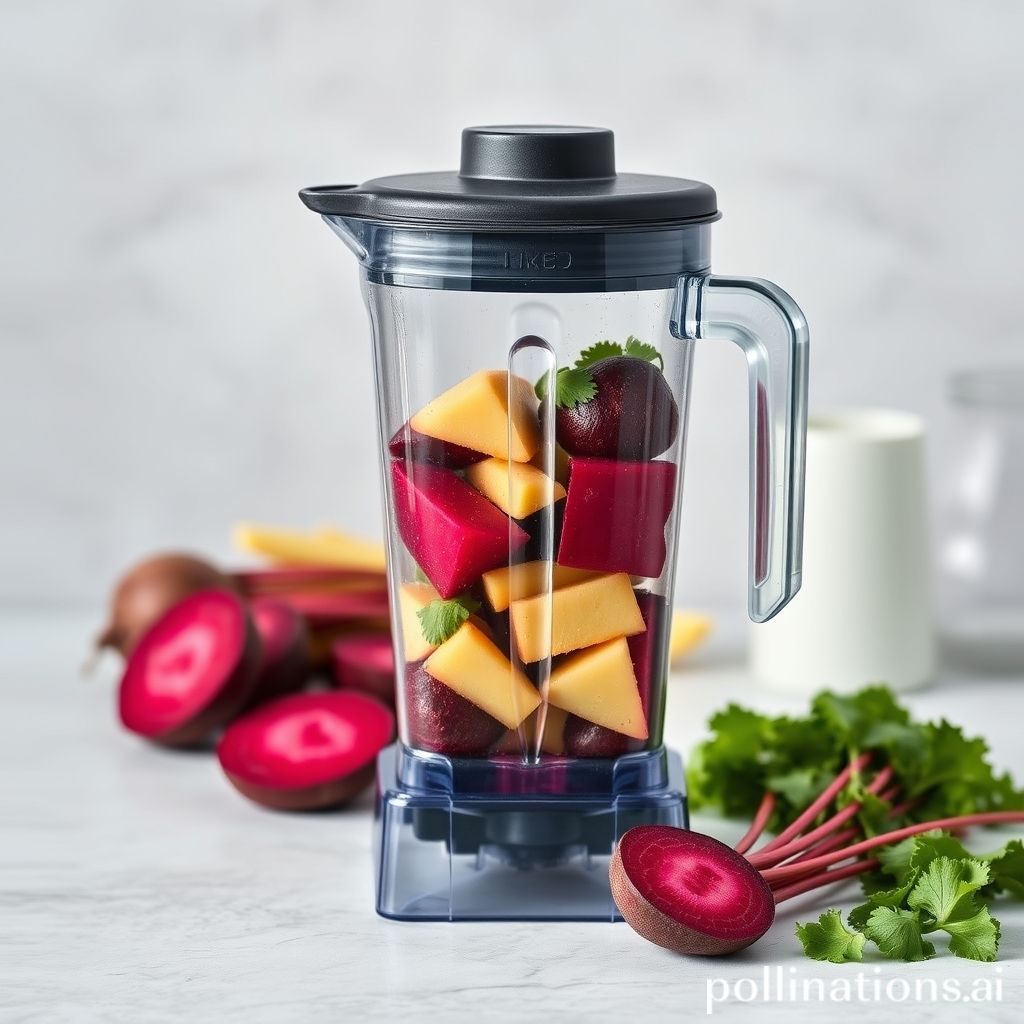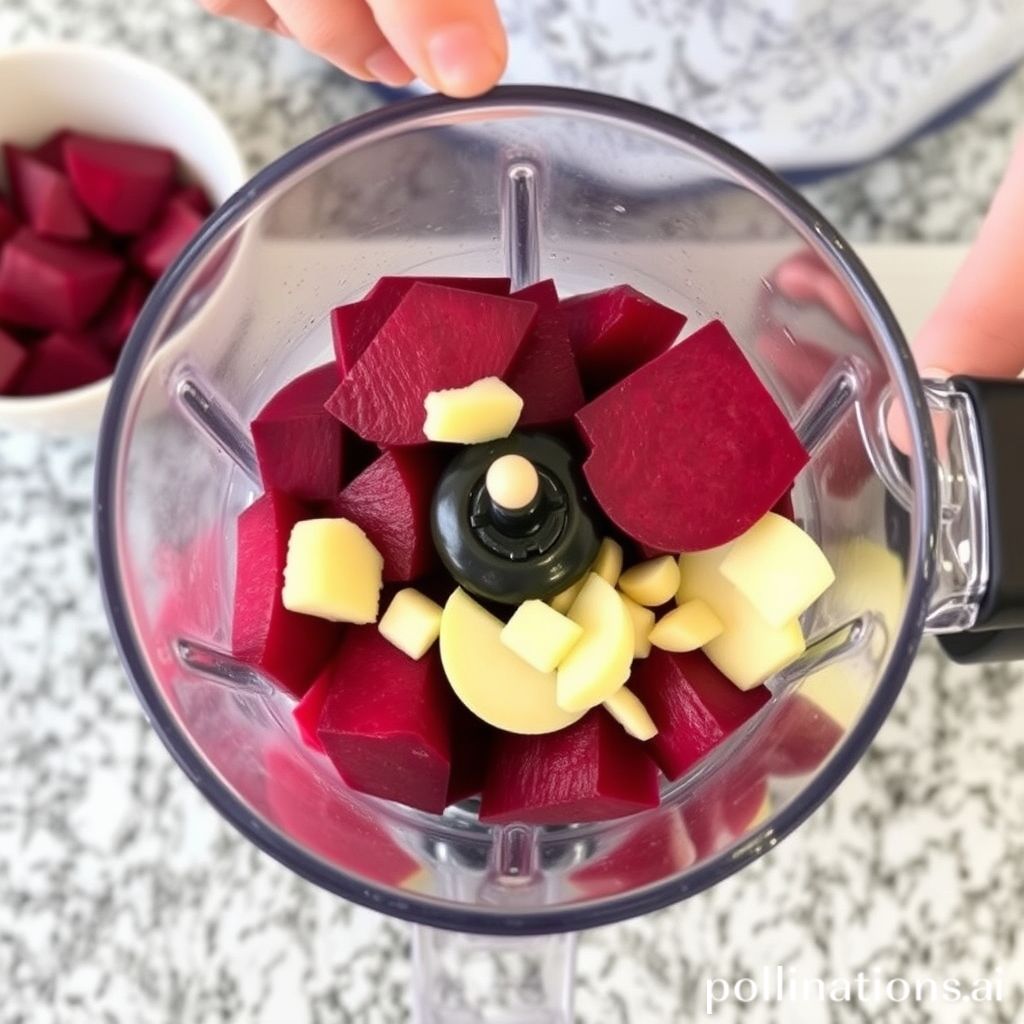Can Beets Be Put In A Blender?
Beets, a versatile and nutritious root vegetable, have piqued the curiosity of many individuals who wonder if they can be blended in a blender. This question arises because people are eager to explore the possibility of creating delicious beet smoothies or incorporating beets into various blended recipes.
The idea of harnessing the power of beets in a blender is intriguing, considering the numerous health benefits they offer. From their high fiber content to their abundance of nitrates, folate, potassium, magnesium, and vitamin C, beets are a treasure trove of nutrients waiting to be unleashed. So, let’s delve into the world of blending beets and discover the endless possibilities they hold.

Table of Contents
Venturing into Benefits of Blending Beets
1. Nutritional Value of Beets
Beets are packed with essential vitamins and minerals, making them a nutrient-dense vegetable. When blended, beets retain their nutritional value, making them a great addition to your diet. They are a good source of folate, manganese, potassium, and vitamin C. Beets also contain fiber, which aids in digestion and helps maintain a healthy weight. Additionally, they are rich in antioxidants that can reduce inflammation and protect against chronic diseases.
2. Health Benefits of Beets
Blending beets offers several health benefits. The high levels of nitrates found in beets can enhance athletic performance by improving blood flow and oxygen delivery to muscles. This can increase endurance and improve exercise efficiency. Beets may also help lower blood pressure due to their nitrate content. Regular consumption of beet juice or blended beets has been associated with improved cardiovascular health. Furthermore, beets have detoxifying properties that support liver function and aid in the elimination of toxins from the body.
3. Blending Vs. Cooking Beets
Blending beets provides a convenient and quick way to incorporate them into your diet. Although cooking beets can also be a healthy option, blending allows you to retain more of their nutritional content. Cooking beets, especially boiling them for a long time, may cause some loss of nutrients. Blending helps break down the fibers and cell walls of beets, making them easier to digest and absorb. By blending beets, you can create delicious and nutritious smoothies, soups, or sauces that preserve the vibrant color and flavor of this versatile vegetable.
Expert Tips: Blend beets to retain their nutrients and enjoy their health benefits. It’s a convenient way to incorporate them into your diet.Choosing the Right Blender for Blending Beets
In terms of blending beets, the choice of blender can make a significant difference. There are various types and features of blenders available to suit different blending needs. Whether you want to make beet smoothies or incorporate beets into other blended recipes, there are certain factors you should consider.
1. Blender Types and Features
Blenders come in different types, each offering unique features for blending beets. Some common types of blenders include:
- Countertop Blenders: These blenders are versatile and powerful, making them ideal for blending beets into smoothies, sauces, and soups. Look for blenders with high wattage and variable speed settings to ensure smooth blending.
- Personal Blenders: These compact blenders are perfect for individual use and are convenient for making single-serving beet smoothies. They often come with travel cups for on-the-go blending.
- Blender/Food Processor Combo: If you want a versatile kitchen appliance, consider a blender that also functions as a food processor. This way, you can easily blend beets and perform other food processing tasks.
2. High-Speed Blenders for Smooth Blending
For the smoothest beet blends, high-speed blenders are an excellent choice. These blenders are specifically designed to handle tough ingredients like beets and ensure a silky-smooth texture. Look for blenders with a powerful motor and sharp blades to effortlessly blend beets into creamy concoctions.
3. Immersion Blenders for Quick and Convenient Blending
If you’re looking for quick and convenient blending, immersion blenders are worth considering. These handheld blenders are easy to use and clean, making them ideal for blending beets directly in pots, bowls, or cups. They are especially useful when making soups or sauces that require blending Whilst cooking.
| Blender Type | Features |
|---|---|
| Countertop Blenders | Versatile, powerful, variable speed settings |
| Personal Blenders | Compact, single-serving, travel cups |
| Blender/Food Processor Combo | Versatility, dual-functionality |
Preparing Beets for Blending
1. Cleaning and Peeling Beets
To prepare beets for blending, it is necessary to clean and peel them properly. Begin by rinsing the beets under cold water to remove any dirt or debris. Use a vegetable brush to gently scrub the surface of the beets. If the skin is tough or blemished, it is recommended to peel them to ensure a smoother texture in the final blended product. To peel beets, use a vegetable peeler or a small knife and carefully remove the skin.
2. Cooking or Raw Beets?
When blending beets, you have the option to use them raw or cooked. Raw beets provide a more vibrant color and a slightly earthy taste, During cooked beets tend to be softer and sweeter. If you prefer a smoother consistency in your blended recipes, it is advisable to cook the beets before blending. To cook beets, you can boil, roast, or steam them until they are tender. Allow the cooked beets to cool before adding them to the blender.
3. Slicing or Dicing Beets for Blending
Prior to adding beets to the blender, it is important to slice or dice them into smaller pieces for easier blending. This will ensure that the beets blend evenly and smoothly. Depending on the recipe or personal preference, you can slice the beets into thin rounds or dice them into small cubes. By cutting the beets into smaller pieces, you also reduce the blending time required to achieve the desired consistency.

Blending Beets into Delicious Recipes
1. Beet Smoothies and Juices
Beet smoothies and juices are a popular way to incorporate this vibrant root vegetable into your diet. To make a beet smoothie, simply peel and chop the beets into small pieces. Then, add them to a blender along with your choice of fruits, such as berries or bananas. Blend until smooth and creamy. For a creamier texture, you can also add yogurt or milk. The natural sweetness of the beets pairs well with the tanginess of citrus fruits, creating a refreshing and energizing beverage.
2. Beet Hummus and Dips
Beet hummus and dips offer a creative twist to traditional recipes. By adding blended beets to your hummus or dip, you not only enhance the flavor but also give it a vibrant pink color that is visually appealing. To make beet hummus, blend cooked beets, chickpeas, garlic, lemon juice, tahini, and olive oil together until smooth. Adjust the quantities according to your taste preferences. Serve it with pita bread or fresh vegetables for a healthy and tasty snack.
3. Beet Soups and Purees
Beet soups and purees are a comforting option for chilly days. To make beet soup, start by sautéing onions, garlic, and chopped beets in a pot. Add vegetable broth and simmer until the beets are tender. Then, carefully blend the mixture until smooth using a blender. Season it with herbs and spices of your choice for added flavor. Serve the beet soup hot with a dollop of yogurt or sour cream for a creamy finish.
| Information |
|---|
| Blending beets in a blender is a convenient way to incorporate them into various recipes. |
| Beet smoothies and juices offer a nutritious and refreshing option. |
| Beet hummus and dips can be made by blending cooked beets with other ingredients. |
| Beet soups and purees provide a comforting and velvety-smooth dish. |
Tips and Tricks for Blending Beets
1. Adding Liquids for Smooth Blending
When blending beets in a blender, it is important to add enough liquids to ensure a smooth consistency. Beets can be dense and fibrous, making it difficult to achieve a silky texture without additional liquids. To prevent strain on your blender’s motor or ending up with a chunky beet mixture, add liquid ingredients such as water, juice, or milk to the blender. The amount of liquid needed may vary depending on the recipe, but a general rule of thumb is to add enough to partially cover the beets.
2. Balancing Flavors with Other Ingredients
Meanwhile beets have a unique earthy flavor, some people may find it overpowering. To balance the flavors and enhance the taste of your beet blend, consider incorporating other ingredients. For a sweeter profile, add fruits like apples, berries, or bananas. Citrus fruits like oranges or lemons can add a refreshing tang. You can also experiment with other vegetables like carrots or spinach to add depth and complexity to the blend. By combining beets with complementary flavors, you can create a more enjoyable and well-rounded beverage.
3. Adjusting Consistency for Desired Texture
The texture of your beet blend can greatly impact the overall experience. Some prefer a thinner consistency, Meanwhile others enjoy a thicker and creamier texture. To achieve your desired consistency, you can make several adjustments. If you want a thinner blend, add more liquid or strain the mixture through a fine mesh sieve to remove any fibrous bits. For a thicker consistency, reduce the amount of liquid or add thickening agents like yogurt or nut butter. Remember to gradually make these adjustments and blend in small increments to achieve the perfect texture.
Conclusion
Beets can indeed be put in a blender. Whether you want to make a delicious beet smoothie or incorporate beets into other blended recipes, using a blender is an effective way to achieve a smooth and creamy texture.
Blending beets not only adds a vibrant color but also retains their nutritional value, making it a convenient and healthy option. So go ahead and experiment with beets in your blender to enjoy their unique flavor and reap the numerous health benefits they offer.
Faq about Blending Beets in a Blender
FAQ 1: Can I blend beets without cooking them?
Yes, you can blend beets without cooking them. Beets can be blended raw, and they will still retain their nutritional value. Conversely, raw beets may have a slightly earthy taste and a firmer texture compared to cooked beets.
FAQ 2: How long does it take to blend beets in a blender?
The blending time for beets in a blender can vary depending on the blender’s power and the desired consistency. On average, it takes about 1-2 minutes to blend beets into a smooth puree. If you prefer a chunkier texture, blending for a shorter time will be sufficient.
FAQ 3: Can I blend beet greens along with the beets?
Yes, you can blend beet greens along with the beets. Beet greens are nutritious and can add a slightly bitter taste to your blend. Ensure that you wash the greens thoroughly before adding them to the blender.
FAQ 4: Can I freeze beet smoothies for later consumption?
Yes, you can freeze beet smoothies for later consumption. Freezing beet smoothies can help preserve their freshness and nutrients. It is recommended to store the smoothies in airtight containers or ice cube trays for easy portioning. When ready to consume, thaw the smoothie in the refrigerator overnight or blend it briefly to restore its texture.
FAQ 5: Can I use a food processor instead of a blender for blending beets?
Yes, you can use a food processor instead of a blender for blending beets. A food processor can effectively puree beets, although the texture may be slightly different compared to a blender. Ensure that you cut the beets into smaller pieces to facilitate blending in the food processor.
Read Similar Post:
1. Improve the Taste of Beet Juice: Tips and Tricks for a More Enjoyable Drink
2. Tantalizing Additions to Enhance the Flavor of Beet Juice

